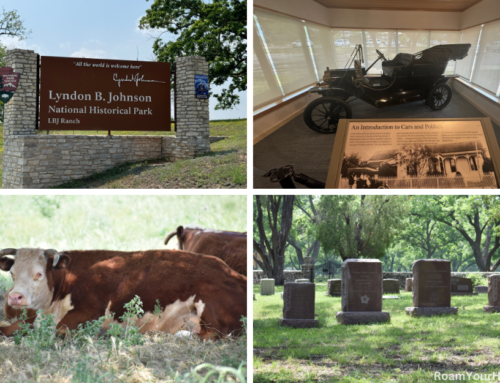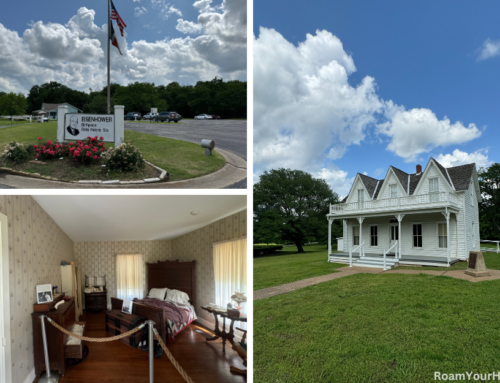
John Wesley Hardin’s Grave
John Wesley Hardin, one of the most notorious gunslingers of the Wild West, is buried in Concordia Cemetery in El Paso, Texas. The historic graveyard holds the stories of outlaws, lawmen, Buffalo Soldiers, and early settlers.
We visited on a winter road trip across the country. We stopped in El Paso for the night and decided to check out some off-the-beaten-path attractions. John Wesley Hardin’s grave was at the top of the list.
Walking through the sunbaked cemetery, you can almost feel the echoes of history. The old cemetery definitely gives off old-west vibes. There is little to no vegetation, just dusty sunbaked ground, and many of the tombstones appear to have been there for over a century.
Visiting John Wesley Hardin’s Grave
Hardin’s grave was easy to find. It’s enclosed by a large protective iron fence due to past vandalism. On an iron plaque at the top of the entrance are his initials, JWH, and two revolvers. Inside what looks like prison bars is a simple yet striking headstone that marks the final resting place of a man who claimed to have killed over 40 men in his lifetime.
John Wesley Hardin: A Brief Life Story of the Infamous Gunslinger
John Wesley Hardin was one of the Old West’s most notorious outlaws and gunfighters. His name is synonymous with violence. He was known for his hot temper and deadly accuracy with six shooters. Hardin’s life was marked by violence, prison, and an unrelenting reputation as a killer. His story is one of crime, survival, and a failed attempt at redemption.
Early Life and First Kill
Born on May 26, 1853, in Bonham, Texas, John Wesley Hardin was raised in a strict, religious household. His father was a Methodist preacher and schoolteacher and named his son after the founder of Methodism, John Wesley. However, despite his religious upbringing, Hardin’s life took a violent turn at an early age.
At just 15 years old, Hardin gunned down his first man. In 1868, he got into a fight with an ex-slave named Mage. Things escalated, and Hardin shot and killed Mage, claiming self-defense. Knowing that Texas law would not be lenient and he would likely hang, he went on the run, beginning his life as a fugitive.
A Notorious Outlaw
Over the next several years, Hardin became involved in numerous gunfights and killings. By his own claim, he killed over 40 men, though historians believe the number was likely lower. He earned a reputation as a deadly gunfighter, feared by lawmen and outlaws alike.

Encounters with Wild Bill Hickok
In 1871, Hardin was in Abilene, Kansas, and was on the radar of the famous lawman Wild Bill Hickok. In his self-serving autobiography, Hardin claims to have gotten the drop on Hickok. Once, while in a saloon, Hardin claims Wild Bill approached him about breaking Abilene’s ordinance against wearing sidearms in town. Hardin goes on to claim he started handing his guns over to Wild Bill, butts forward, then quickly rolled them over in his hands so Wild Bill Hickok was staring down the barrels. Hardin said he kept his guns as Hickok backed down. Of course, Wild Bill Hickok was long dead when this claim was made.
Old-west historians generally believe that Hardin had no intention of killing Hickok, instead was trying to impress him. It’s known that Hardin admired and was fascinated by Wild Bill. He reveled in being seen on intimate terms with the celebrated gunfighter.
“So mean, he once shot a man for snoring”
Hardin’s most famous claim to fame occurred while in Abilene. He killed a man for snoring.
The story goes that on August 6, 1871, after a night of heavy drinking whiskey with a couple of friends, they all retired for the evening. In the middle of the night, he woke to loud snoring from his friend’s room next door. First, he yelled a few times to “roll over,” getting more irritated each time as the snoring continued.
Finally, laying there irate, Hardin drunkenly fired off a few shots through the wall, trying to wake him up. One of those shots made sure the man never woke up again, hitting him in the heart and killing him.
While he did not mean to kill his buddy, he still broke the law. Half-dressed and half-drunk, Hardin took off as Hickok was arriving with four deputies.
“Now, I believed,” Hardin later wrote, “that if Wild Bill found me in a defenseless condition, he would take no explanation but would kill me to add to his reputation.”
The local newspaper the following day reported, “A man was killed in his bed at a hotel in Abilene, Monday night, by a desperado called ‘Arkansas.’ The murderer escaped. This was his sixth murder.”
Hardin would leave Abilene and never return. The incident while likely exaggerated earned Hardin a reputation as a man “so mean, he once shot a man for snoring”. Some years later, Hardin casually referenced the episode: “They tell lots of lies about me,” he complained. “They say I killed six or seven men for snoring. Well, it ain’t true. I only killed one man for snoring.”
By the mid-1870s, Hardin had married Jane Bowen and briefly attempted to settle down. However, he could not escape his violent past. He became embroiled in the Sutton-Taylor feud, a bloody Texas range war. His involvement led to more killings, further cementing his reputation as one of the deadliest men in the West.
“A bullet to the front of the head demonstrates good marksmanship. A bullet to the back of the head demonstrates good judgment.”– John Wesley Hardin
Capture and Imprisonment
In 1877, Hardin’s luck ran out. After being tracked by Texas Rangers, he was captured while attempting to board a train in Pensacola, Florida. He was tried and sentenced to 25 years in prison for the murder of Deputy Sheriff Charles Webb.
During his time in prison, Hardin claimed to have reformed. He studied law and even wrote an autobiography, attempting to paint himself as a misunderstood figure rather than a ruthless killer. In 1894, after serving 17 years, he was released from prison and received a pardon.
A Failed Redemption and Violent End
Following his release, Hardin moved to El Paso, Texas, and attempted to practice law. However, his violent reputation followed him. He became involved in local disputes and reportedly hired hitmen to kill his enemies.
On August 19, 1895, Hardin’s past finally caught up with him. While he was playing dice in the Acme Saloon in El Paso, he was shot in the back of the head by John Selman, a local lawman and former outlaw. Hardin died instantly, bringing an end to the life of one of the Old West’s most infamous gunfighters.
John Wesley Hardin remains one of the most well-known figures of the Wild West. His legend, fueled by his own exaggerated stories, continues to capture the imagination of history buffs and Western enthusiasts. Whether seen as a ruthless killer or a product of a violent era, Hardin’s name is forever linked to the lawless frontier days of Texas.
Beyond Hardin’s story, Concordia Cemetery is a fascinating place to explore, with over 60,000 graves and countless tales of the Old West. It’s a quiet, reflective spot that offers a unique glimpse into Texas history. If you ever find yourself in El Paso, take an hour to walk through this legendary burial ground—you won’t regret it.




